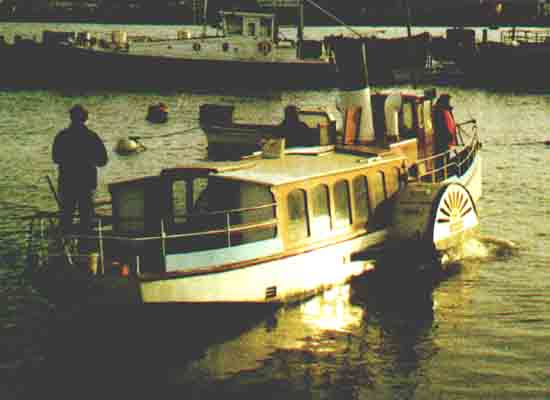
P.S. Monarch
Progress Report April 2003
Brian Waters, designer and constructor, writes ...
A huge amount of work has been done since the boat was brought to steaming condition, and there now seems to be far more sailing and less breakdown as time goes by.
December '03: 'Monarch' sailed on trials for the first time from Lemon's Jetty at Strood. During this and several successive runs a number of modifications have been necessary, nearly all in the region of the air pump, feed pump and hotwell. Initially drive problems had to be overcome, for the feed pump and air pump are driven by a layshaft geared to the port paddle shaft, and these gears are heavily loaded. Then pipework had to be altered to solve water flow problems with these pumps. They appear to be working quite happily now.
Some of the engine trials are conducted with the boat tied up alongside the jetty, and it was very noticeable that the engine did not run at all smoothly in this situation, particularly when running ahead, when maximum cut-off was needed to make it run at all. It does run much more easily when going astern and this is put down to the curvature of the paddle floats, which have a much superior grip on the water in the ahead direction.
The feathering wheels which have water lubricated teflon (not PTFE as previously stated) bearings have behaved very well. With 'Monarch' running free from mooring ropes the engine runs happily on an early cut-off setting, and tests are being carried out to establish the earliest cut-off at which the engine keeps going, as this will facilitate a slow pier approach without actually stopping the engine, so that it can be put straight into reverse and avert the risk of stalling when berthing alongside.
An engine movement indicator driven by a speedometer cable attached to the layshaft has proved unsatisfactory, and an instrument based on an electric stepper motor is in the design stage. This, it is hoped, will greatly assist manoeuvring when bringing the boat alongside, because it is not possible to watch the movement of the crankshaft when standing at the controls situated in the wheelhouse.
The engine starts easily and rarely needs the simpling valve, and it looks as though the concept of wheelhouse-located engine controls, which are based on those of a locomotive or traction engine, is proving successful. The next stage in commissioning 'Monarch' is to go on the slipway for a good clean and paint up and for surveying.

P.S. 'Monarch' leaves Strood on trial for the first time. Photo by Nick James